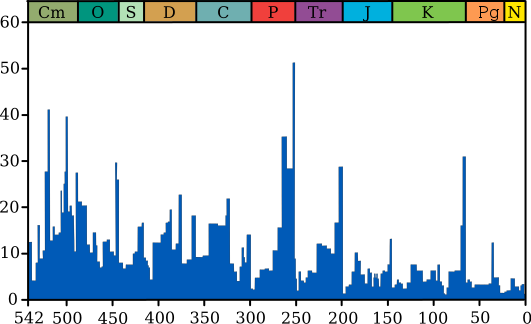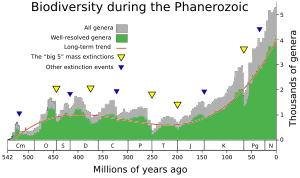Datei:Extinction intensity.svg

Originaldatei (SVG-Datei, Basisgröße: 531 × 324 Pixel, Dateigröße: 90 KB)
![]()
Diese Datei und die Informationen unter dem roten Trennstrich werden aus dem zentralen Medienarchiv Wikimedia Commons eingebunden.
A modified version of Image:Extinction Intensity.svg.
Changes:
- Time runs from left to right (millions of years ago). Vertical axis is apparent percentage (not the absolute number) of marine animal genera becoming extinct.
- Periods are coloured as per the Paris system - see w:Template:Period color for full explanation
- Text removed so wikilinks can be floated over. See w:Template:Annotated image/Extinction for implementation.
- Cubic polynomial removed as this doesn't convey any useful information and is mainly an artefact.
- The caption on the original file is: Marine Genus Biodiversity: Extinction Intensity

|
Es ist erlaubt, die Datei unter den Bedingungen der GNU-Lizenz für freie Dokumentation, Version 1.2 oder einer späteren Version, veröffentlicht von der Free Software Foundation, zu kopieren, zu verbreiten und/oder zu modifizieren; es gibt keine unveränderlichen Abschnitte, keinen vorderen und keinen hinteren Umschlagtext.
Der vollständige Text der Lizenz ist im Kapitel GNU-Lizenz für freie Dokumentation verfügbar.http://www.gnu.org/copyleft/fdl.htmlGFDLGNU Free Documentation Licensetruetrue |
| Diese Datei ist unter der Creative-Commons-Lizenz „Namensnennung – Weitergabe unter gleichen Bedingungen 3.0 nicht portiert“ lizenziert. | ||
| ||
| Diese Lizenzmarkierung wurde auf Grund der GFDL-Lizenzaktualisierung hinzugefügt.http://creativecommons.org/licenses/by-sa/3.0/CC BY-SA 3.0Creative Commons Attribution-Share Alike 3.0truetrue |
Beschreibung
- Adapted from Image:Extinction Intensity.svg
This figure shows the genus extinction intensity, i.e. the fraction of genera that are present in each interval of time but do not exist in the following interval. The data itself is taken from Rohde & Muller (2005, Supplementary Material), and are based on the Sepkoski's Compendium of Marine Fossil Animal Genera (2002). Note that these data do not represent all genera that have ever lived, but rather only a selection of marine genera whose qualities are such that they are easily preserved as fossils.
In the original version of this chart, the "Big Five" mass extinctions (Raup & Sepkoski 1982) are labeled in large font, and a variety of other features are labeled in smaller font. The two extinction events occurring in the Cambrian (i.e. Dresbachian and Botomian) are very large in percentage magnitude, but are not well known because of the relative scarcity of fossil producing life at that time (i.e. they are small in absolute numbers of known taxa). The Middle Permian extinction is now argued by many to constitute a distinct extinction horizon, though the actual extinction amounts are sometimes lumped together with the End Permian extinctions in reporting. As indicated, the "Late Devonian" extinction is actually resolvable into at least three distinct events spread over a period of ~40 million years. As these data are derived at the genus level, one can anticipate that the number of species extinctions is a higher percentage than shown here.
Many of the extinction events appear to be somewhat extended in time. In at least some cases this is the result of a paleontological artifact known as the Signor-Lipps effect (Signor & Lipps 1982). Briefly, this is the observation that inadequate sampling can cause a taxon to seem to disappear before its actual time of extinction. This has the effect of making an extinction event appear extended even if it occurred quite rapidly. Hence, when estimating the true magnitude of an extinction event it would be common to combine together the events occurring over several preceding bins as long as they also show excess extinctions. This explains why many estimates of the magnitude of an extinction event may be larger than the 20-30% shown as the largest single bin for most of the extinctions shown here.
References
- Raup, D. & Sepkoski, J. (1982). "Mass extinctions in the marine fossil record". Science 215: 1501–1503. DOI:10.1126/science.215.4539.1501.
- Rohde, R.A. & Muller, R.A. (2005). "Cycles in fossil diversity". Nature 434: 209-210. DOI:10.1038/nature03339.
- Sepkoski, J. (2002) A Compendium of Fossil Marine Animal Genera (eds. Jablonski, D. & Foote, M.) Bull. Am. Paleontol. no. 363 (Paleontological Research Institution, Ithaca, NY).
- Signor, P. and J. Lipps (1982) "Sampling bias, gradual extinction patterns and catastrophes in the fossil record", in Geologic Implications of Impacts of Large Asteroids and Comets on the Earth, I. Silver and P. Silver Eds, Geol. Soc. Amer. Special Paper 190, Boulder Colo. p. 291-296.
For comparison

Kurzbeschreibungen
In dieser Datei abgebildete Objekte
Motiv
image/svg+xml
Dateiversionen
Klicke auf einen Zeitpunkt, um diese Version zu laden.
| Version vom | Vorschaubild | Maße | Benutzer | Kommentar | |
|---|---|---|---|---|---|
| aktuell | 09:02, 21. Mai 2008 |  | 531 × 324 (90 KB) | wikimediacommons>Smith609 |
Dateiverwendung
Die folgenden 11 Seiten verwenden diese Datei:
- Grande Coupure
- Kambro-Ordovizisches Massenaussterben
- Massenaussterben
- Ordovizisches Massenaussterben
- Paläoklimatologie
- Perm-Trias-Grenze
- Trias-Jura-Grenze
- Wikiup:Hauptseite/Archiv/15. Februar 2019
- Wikiup Diskussion:Hauptseite/Artikel des Tages/Archiv/Vorschläge/2019/Q1
- Vorlage:Annotiertes Bild Massenaussterben
- Spezial:Badtitle/NS100:Klimawandel/Galerie